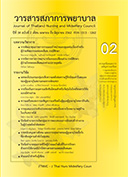Continuing Hospital-to-Home Palliative Care: A Southern Thai Context
Keywords:
palliative care, continuing hospital-to-home palliative care, southern Thai contextAbstract
Objective: To describe 1) continuing hospital-to-home palliative care services in southern Thailand; and 2) supportive factors for, and obstacles to, provision of continuing hospital-to-home palliative care in southern Thailand.
Design: Qualitative multiple-case study.
Methodology: The research sites were purposively selected, based on these criteria, namely, 1) being tertiary care centres or regional hospitals; 2) providing continuing hospital-to-home palliative care services; and 3) serving as healthcare centres with links to secondary care hospitals, primary care units or sub-district health-promoting hospitals. In total, four regional or tertiary hospitals were selected. The participants were (1) terminal patients and their family caregivers and (2) stakeholders involved in palliative care services, totalling 92. Interviews, focus-group discussions, and observation were data collection methods. The data were analysed using content analysis.
Results: Three models of continuing hospital-to-home palliative care were identifed in the southern Thai context: (1) hospital-based palliative care; (2) integrated community-based palliative care; and (3) volunteer-supported palliative care. Voluntary assistance, support from organisations’ administrators, and collaborative community networking were identifed as major supporting factors. Limited access to the use of analgesics, compartmentalisation without coordination, lack of knowledge and skills , insuffciency and workload of palliative care personnel and shortage of medical equipment were identifed as major obstacles.
Recommendations: To provide patients and their families with continuing services and improve their quality of life, it is necessary that healthcare organisation administrators actively integrate palliative care as one major healthcare service provided by each hospital, support healthcare personnel at all levels and in all felds of specialisation to optimise their palliative care expertise, promote coordination through effcient communication to ensure uninterrupted flow of information, and systematically improve medication and medical equipment management at all levels of service. Also, further research on effects of different palliative care models is recommended.
Downloads
References
Pain Symptom Manage. 2018;55(2):S163-S9.
2. World Health Organization. Palliative care Geneva: World Health Organization; 2018 [cited 2018 Jan 9].
Available from: https://www.who.int/news-room/fact-sheets/detail/palliative-care.
3. Connor SR, Bermedo MCS, editors. Global atlas of palliative care at the end of Life. London: Worldwide
Hospice Palliative Care Alliance; 2014.
4. The Economist Intelligence Unit. The 2015 Quality of Death Index Ranking palliative care across the
world 2015 [cited 2018 Jan 9]. Available from: https://www.eiuperspectives.economist.com/healthcare/2015-quality-death-index.
5. National Health Security Offce. Management Manual for National Health Security Fund, Fiscal
Year 2016, Volume 1 Management of medical services,paid by head. Bangkok: Thanapress company; 2015.(in Thai)
6. Tasprasit T, Phimdee P, Mongkalchai S, Jullapan P,Puttatum Y. The development of the palliative care system for end of life patients at Udonthani hospital.Nursing Journal of The Ministry of Public Health. 2013;23(1):80-90. (in Thai)
7. Kumpol S. Holistic health care in terminally ill patients A participation through the Buddhist way under the Isan culture context: a case study of urban areas In Khon Kaen. Journal of Hunanities and Social Sciences Mahasarakham University. 2012;31(5):179-201.(in Thai)
8. Luvira V, Srikha D, Prirojkul S. Community-based palliative care by volunteers: perceptions of village health
volunteers in a community of Khon Kaen province. Srinagarind Medical Journal. 2013;28(2):199-204.(in Thai)
9. Sawasdeenarunat V, Taneerat A, Wisettham T. The development of a palliative care model for terminal cancer patients at Maharaj Nakhon Si Thammarat hospital. Nursing Journal of the Ministry of Public Health. 2015;25(1):144-56. (in Thai)
10. Morrakot P, Nilmanat K, Matchim Y. Impacts of an adaptation-promoting programme on the caregiving relatives of terminal chronic disease patients. Thai Journal of Nursing Council. 2015;30(2):33-45. (in Thai)93
11. Nilmanat K, Matchim Y, Manasurakarn J, Kongsuwan W, Meesunthorn K, Prompahakul C. Terminal patient care in a Muslim community: a case Study in a southern-Thai context. Thai Journal of Nursing Council. 2016;31(3):37-52. (in Thai)
12. D’Angelo D, Mastroianni C, Hammer JM, Piredda M, Vellone E, Alvaro R, et al. Continuity of care during end of life: an evolutionary concept analysis. Int J Nurs Knowl 2015;26(2):80-9.
13. Yin RK. Case study research design and methods. 5th ed. Thousand Oaks, CA: Sage; 2014.
14. Miles MB, Huberman AM. Qualitative data analysis. 2nd ed. Thousand Oaks, CA: Sage Publications; 1994.
15. Lincoln YS, Guba EG. Naturalistic inquiry. Beverly Hills, Calif: Sage Publication; 1985.
16. Elo S, Kyngäs H. The qualitative content analysis process. J Adv Nurs. 2008;62(1):107-15
17. Gamondi C, Larkin P, Payne S. Core competencies in palliative care: an EAPC white paper on palliative care education – part 1. Eur J Palliat Care. 2013;20(2):86-91.
18. Pokpalagon P. Palliative care model in Thailand. Nursing Journal of The Ministry of Public Health.2016;26(3):41-51. (in Thai)
19. Wangthong A, Wangthong A, watsen T, Suttarangsri W. Clients’ perspectives on humanized nursing care within
a multicultural context: a case study of Nongjik district,Pattani province. Nursing Journal of The Ministry of
Public Health 2013;23(3):35-44. (in Thai)
20. Sirisoparuk S, Oumtanee A. Experience of being a professional nurse providing humanized care for
patients. Journal of The Royal Thai Army Nurses. 2014;15(2):289-97. (in Thai)
21. Brito-Pons G, Librada-Flores S. Compassion in palliative care: a review. Curr Opin Support Palliat Care. 2018;12(4):472-9.
22. Callaway MV, Connor SR, Foley KM. World Health Organization public health model: a roadmap for
palliative care development. J Pain Symptom Manage.2018;55(2S):S6-13.
23. Sae-hlee D, Namtassnee S, Thipthungthae S, Sumamal T, Tunsuthepweravong C, Yana T, editors. District Health
System (DHS). Bangkok: Public Health Administration Offce, Offce of the Permanent Secretary for Public Health; 2014. (in Thai)
24. Lewis JM, DiGiacomo M, Luckett T, Davidson PM, Currow DC. A social capital framework for palliative
care: supporting health and well-being for people with life-limiting illness and their carers through social relations and networks. J Pain Symptom Manage.2013;45(1):92-103.
25. Phungrassami T, Thongkhamcharoen R, Atthakul N. Palliative care personnel and services: a national survey in Thailand 2012. J Palliat Care 2013;29(3):133-9.
26. Aldridge MD, Hasselaar J, Garralda E, Eerden Mvd, Stevenson D, McKendrick K, et al. Education, implementation, and policy barriers to greater integration of palliative care: a literature review.Palliat Med. 2016;30(3):224-39.








